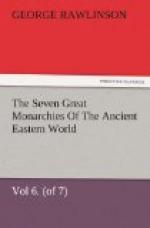The sale of the Osrhoene territory to Abgarus by Pacorus was not a fact of much consequence. It may indicate an exhaustion of his treasury, resulting from the expenditure of vast sums on the enlargement and adornment of the capital, but otherwise it has no bearing on the general condition of the Empire. Perhaps the Parthian feudatories generally paid a price for their investiture. If they did not, and the case of Abgarus was peculiar, still it does not appear that his purchase at all altered his position as a Parthian subject. It was not until they transferred their allegiance to Rome that the Osrhoene princes struck coins, or otherwise assumed the status of kings. Up to the time of M. Aurelius they continued just as much subject to Parthia as before, and were far from acquiring a position of independence.
There is reason to believe that the reign of Pacorus was a good deal disturbed by internal contentions. We hear of an Artabanus as king of Parthia in A.D. 79; and the Parthian coins of about this period present us with two very marked types of head, both of them quite unlike that of Pacorus, which must be those of monarchs who either contended with Pacorus for the crown, or ruled contemporaneously with him over other portions of the Parthian Empire. [PLATE III., Fig. 2.] Again, towards the close of Pacorus’s reign, and early in that of his recognized successor, Chosroes, a monarch called Mithridates is shown by the coins to have borne sway for at least six years—from A.D. 107 to 113. This monarch commenced the practice of placing a Semitic legend upon his coins, which would seem to imply that he ruled in the western rather than the eastern provinces. The probability appears, on the whole, to be that the disintegration which has been already noticed as having commenced under Volagases I. was upon the increase. Three or four monarchs were ruling together in different portions of the Parthian world, each claiming to be the true Arsaces, and using the full titles of Parthian sovereignty upon his coins. The Romans knew but little of these divisions and contentions, their dealings being only with the Arsacid who reigned at Ctesiphon and bore sway over Mesopotamia and Adiabene.
Pacorus must have died about A.D. 108, or a little later. He left behind him two sons, Exedares and Parthamasiris, but neither of these two princes was allowed to succeed him. The Parthian Megistanes assigned the crown to Chosroes, the brother of their late monarch, perhaps regarding Exedares and Parthamasiris as too young to administer the government of Parthia satisfactorily. If they knew, as perhaps they did, that the long period of peace with Rome was coming to an end, and that they might expect shortly to be once more attacked by their old enemy, they might well desire to have upon the throne a prince of ripe years and approved judgment. A raw youth would certainly have been unfit to cope with the age, the experience, and the military genius of Trajan.




